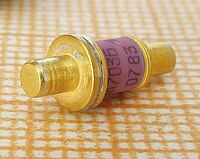
Photo from wikipedia
In many industrial applications, the quality of mixing between different materials is fundamental to guarantee the desired properties of products. However, properly modeling and understanding polymer mixing presents noticeable difficulties,… Click to show full abstract
In many industrial applications, the quality of mixing between different materials is fundamental to guarantee the desired properties of products. However, properly modeling and understanding polymer mixing presents noticeable difficulties, because of the variety and complexity of the phenomena involved. This is also the case with the Cavity Transfer Mixer (CTM), an add-on to be mounted downstream of existing extruders, to improve distributive mixing. The present work proposes a fully three-dimensional model of the CTM: a finite element solver provides the transient velocity field, which is used in the mapping method implementation to compute the concentration field evolution and quantify mixing. Several simulations are run assessing the impact on mixing of geometrical and functioning parameters. In general, the number of cavities per row should be limited and the cavity size rather big to guarantee good mixing quality. © 2017 American Institute of Chemical Engineers AIChE J, 2017
Journal Title: Aiche Journal
Year Published: 2018
Link to full text (if available)
Share on Social Media: Sign Up to like & get
recommendations!